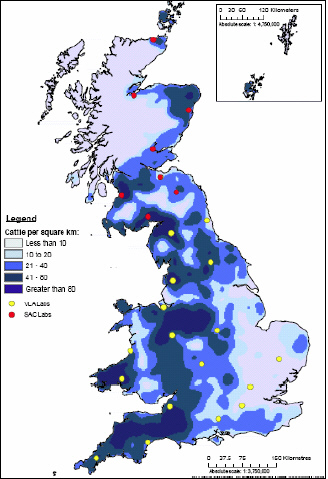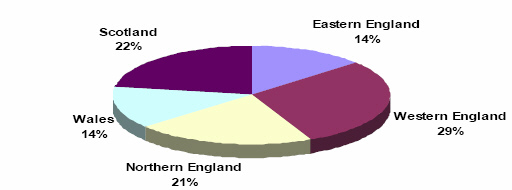



UK Cattle Disease Quarterly Surveillance Report (to September 2008)
This report, by the Veterinary Laboratories Agency, monitors trends in the major endemic cattle diseases. The report is compiled using disease data gathered by the network of VLA Regional Laboratories.
 July – September, 2008 Published December 2008 Contents OVERVIEW (here) Introduction to GB Report Factors influencing disease and submission rates Notifiable diseases reported Farm visit investigations Chemical food safety incidents Endemic disease surveillance Unusual and new diseases Syndromic disease surveillance – bovine respiratory disease Scanning surveillance for new and emerging disease |
Overview
Factors influencing disease and submission rates
Many factors combine to influence the patterns of disease in cattle, and the ability to detect changes to these patterns through scanning and active surveillance. They include:
Cattle Demographics
The UK cattle population is the third largest in the EU and comprises 8.6 million animals on 77,736 premises (July 2008, RADAR, Defra). The map below shows the density of cattle and the location of the diagnostic laboratories that contribute data to this report.
Distribution of Cattle and location of Diagnostic Centres in Great Britain (2007)

In the 3rd quarter of 2008, a total of 63.3% of the national herd were beef cattle and 35.6% were dairy cattle, which was unchanged from same quarter in the previous year. An overall decrease (1.6%) in the number of cattle was observed between quarter 3 of 2007 and 2008, with the majority of the reduction in beef cattle (2.3%) and a smaller decline in dairy cattle (0.8%).
A larger reduction in premises stocking dairy cattle (4.8%) was observed compared to the reduction in premises stocking beef (3.3%). This is likely to be a result of the closing of smaller enterprises and increasing herd sizes of the remaining dairy herds.
The regional distribution of cattle is shown in figure 2, which was similar to the distribution in quarter in 2007.
Distribution of cattle in GB.

Weather and climate
In July, mean temperatures were slightly above average in most of England and Wales but more so in Scotland (averaging more than 1oC). Rainfall was generally above or well above average across most of England and Wales, but close to average across East Anglia. Rainfall over Scotland ranged from below average across the north-west to above average across the south-east.
In August, mean temperatures were slightly (0.5-1oC) above average in all of GB but it was a very wet month across GB (about 150% of average rainfall for August) with widespread flooding in parts of eastern Scotland.
In September, mean temperatures were generally close to average across England and Wales but slightly above average across Scotland. Wales had its coolest September since 1994. Rainfall varied widely – with much less than usual in Scotland and more south of the border, especially in Northern England.
Economics of the cattle industries
In general when profit margins of the industries are acceptable there is a greater tendency to use disease diagnosis in the health management of the individual herd. The effectiveness of the scanning surveillance carried out by SAC and VLA is therefore related directly to the financial health of the industry
Dairy sector
Milk production in the UK is well below quota at present. The average farm gate milk price is around 27 pence per litre (ppl), and the cost of production on the majority of dairy farms is at least 28 ppl. The cost of red diesel has dropped nearly 20 pence per litre during this quarter after a fall in crude oil price. Large amounts of wheat unsuitable for milling has resulted in cheaper feed wheat (below £100/tonne); however, the price of all other costs has risen.
The poor weather during harvest has resulted in a shortage of good quality straw reduced grain quality and highly variable silage quality (particularly second cut). This is likely to affect cow feeding and possible incidence of environmental mastitis. The calf price has fallen considerably, possibly associated with a reduction of calves exported to the Netherlands.
Beef sector
Market prices remain high compared to last year: for this quarter on average, finished steers fetched 151 pence per kilogram compared to 110 pence per kilogram for last year.
The number of steers, heifers and cows and adult bulls that were slaughtered for human consumption each increased: steers from 67,000 to 86,000. Young bull slaughters remained the same at 21,000 as did calves at approximately 4,000 head.
Further Reading
| - | You can view the full report by clicking here. |
December 2008


